I'm sure some of my terminology here will be incorrect, but I was curious if the idea behind using scarf joints to form the bow and stern parts is more about keeping with traditional ship building techniques, or are there advantages to using scarf joints over just cutting a single piece of wood to the shape you want.
You are using an out of date browser. It may not display this or other websites correctly.
You should upgrade or use an alternative browser.
You should upgrade or use an alternative browser.
Question about scarf joints instead of a one piece keel.
The reason I ask is I'm about to start cutting out pieces for a practice project, using the parts from my kit as a template.
I cut this out yesterday.
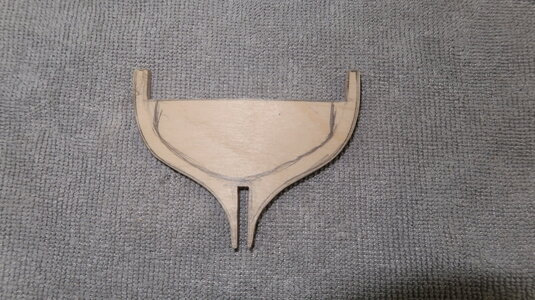
The idea is to use the bulkhead pieces but then cut along that interior pencil line to make them more like frames. Planning on cutting more frames than the 8 bulkheads in the kit, plus I'd like to reshape the bow a bit.
I'll be building a jig for laying the keel and setting the frames, that's why I asked about using the scarf joints on the keel. I'm going to extend it a bit longer than the kit, and as far making it a one piece keel instead multiple pieces using scarf joints, does it really matter in this case?
Thanks;
Charles
I cut this out yesterday.

The idea is to use the bulkhead pieces but then cut along that interior pencil line to make them more like frames. Planning on cutting more frames than the 8 bulkheads in the kit, plus I'd like to reshape the bow a bit.
I'll be building a jig for laying the keel and setting the frames, that's why I asked about using the scarf joints on the keel. I'm going to extend it a bit longer than the kit, and as far making it a one piece keel instead multiple pieces using scarf joints, does it really matter in this case?
Thanks;
Charles
There's doing it the easy way and there's doing it the way it was done . I chose the easy way(one piece). My thought being that I want tis piece straight. You can always scribe in the scarf after if you are looking for "the look". There is no advantage to actually scarfing it. I did scarf the keelson though, just to prove to myself that I could.
. I chose the easy way(one piece). My thought being that I want tis piece straight. You can always scribe in the scarf after if you are looking for "the look". There is no advantage to actually scarfing it. I did scarf the keelson though, just to prove to myself that I could.
- Joined
- Dec 1, 2016
- Messages
- 5,127
- Points
- 728

i agree with Don scarfs and joinery is just for looks there is no structural advantage.
i am doing a lot of joinery on the Tecumseth project because i like woodworking and like Don said "just to prove to myself that I could."
doing all that joinery work for the most part does not add value to the model. Hahn skipped a lot of joinery and made parts in one piece and still he sold models in the $35,000.00 range.
the only reason i can think of to do all the joinery is if a client asks and pays for it or your doing a model for a museum that requires exact fine detail.
i am doing a lot of joinery on the Tecumseth project because i like woodworking and like Don said "just to prove to myself that I could."
doing all that joinery work for the most part does not add value to the model. Hahn skipped a lot of joinery and made parts in one piece and still he sold models in the $35,000.00 range.
the only reason i can think of to do all the joinery is if a client asks and pays for it or your doing a model for a museum that requires exact fine detail.
Last edited:
Many thanks Don and Dave;
I like the idea from a woodworking perspective, just to see if I can do it kind of thing, but seeing as how I have my hands full right now with just planking, I think I'll leave the fancy joinery for a future project.
I like the idea from a woodworking perspective, just to see if I can do it kind of thing, but seeing as how I have my hands full right now with just planking, I think I'll leave the fancy joinery for a future project.
- Joined
- Dec 1, 2016
- Messages
- 5,127
- Points
- 728

Many thanks Don and Dave;
I like the idea from a woodworking perspective, just to see if I can do it kind of thing, but seeing as how I have my hands full right now with just planking, I think I'll leave the fancy joinery for a future project.
there are a couple ways to view the idea of adding joinery to a model and it depends on the type of model your building.
kits are more of a facade which shows the basic outer appearance and the inner structure is simplified, rather than framing it is replaced with bulkheads, rather and a deck with deck beams and planking a sheet of wood is used with scoring to show individual planking. Something like an architectural model where only the general outer appearence is necessary. There is no inner structure and no need to add joinery, it is either you add all the joinery or no joinery to a model.
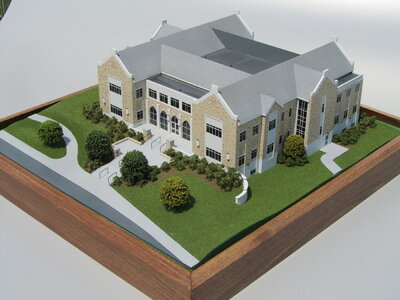
now if you want to show in a model how a structure is built like post and beam structure then the joinery becomes into view and it is a big part of the overall models purpose.
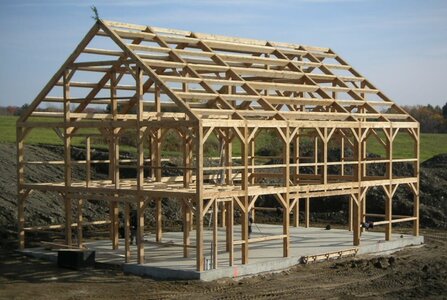
in this type of model you would add the joinery.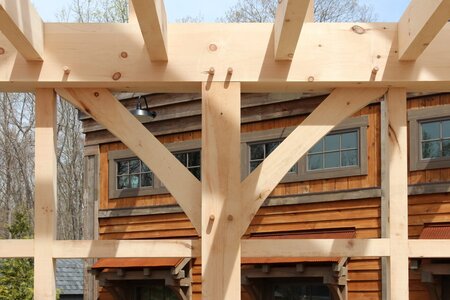
The Tecumseth is a project to reconstruct a historic ship and the model is intended to not only show what it looked like but also how it was built. In a kit model which is showing only the outer appearance it is acceptable to score in the joinery that would be seen. Leaving out any joinery is also acceptable because the models intent is what the ship looked like and not how it was built.
Last edited:
Is that a new shop or something you're building?
- Joined
- Dec 1, 2016
- Messages
- 5,127
- Points
- 728

no that is not a new shop nor is it anything i am building
I like your analogy and illustrations of structure and skin to architectural examples. Our presentations will determine which direction to take for the end visual effect . . . unless we choose to go the whole nine yards as a part of the hobby time itself . . . knowing that it was done, visible or not. Just a personal opinion and decision process. Rich (PT-2)there are a couple ways to view the idea of adding joinery to a model and it depends on the type of model your building.
kits are more of a facade which shows the basic outer appearance and the inner structure is simplified, rather than framing it is replaced with bulkheads, rather and a deck with deck beams and planking a sheet of wood is used with scoring to show individual planking. Something like an architectural model where only the general outer appearence is necessary. There is no inner structure and no need to add joinery, it is either you add all the joinery or no joinery to a model.
View attachment 260281
now if you want to show in a model how a structure is built like post and beam structure then the joinery becomes into view and it is a big part of the overall models purpose.
View attachment 260282
in this type of model you would add the joinery.
View attachment 260287
The Tecumseth is a project to reconstruct a historic ship and the model is intended to not only show what it looked like but also how it was built. In a kit model which is showing only the outer appearance it is acceptable to score in the joinery that would be seen. Leaving out any joinery is also acceptable because the modesl intent is what the ship looked like and not how it was buit.
- Joined
- Dec 1, 2016
- Messages
- 5,127
- Points
- 728

I like your analogy and illustrations of structure and skin to architectural examples. Our presentations will determine which direction to take for the end visual effect . . . unless we choose to go the whole nine yards as a part of the hobby time itself . . . knowing that it was done, visible or not. Just a personal opinion and decision process. Rich (PT-2)
if you are documenting a ship with a model and research and a build log then visible or not in the finished model is not the point because you are building the model as the real ship was built and the detal that is now covered in the model is still visible in the build log.
beam joinery at the cabin sill on the shipwreck
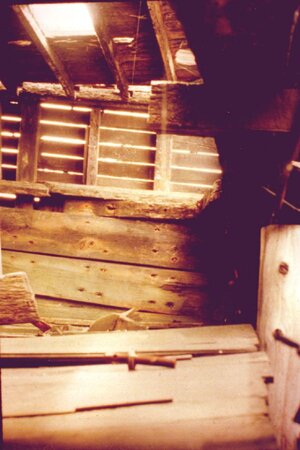
and the same joinery on the model which is now covered with deck planks.
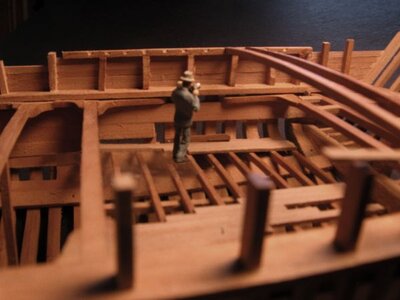
you could say plank on bulkhead ship kits are like a hollow bunny. There is nothing inside that would provide information on the structure of an actual ship.

if you are documenting a ship with a model and research and a build log then visible or not in the finished model is not the point because you are building the model as the real ship was built and the detal that is now covered in the model is still visible in the build log.
beam joinery at the cabin sill on the shipwreck

and the same joinery on the model which is now covered with deck planks.

you could say plank on bulkhead ship kits are like a hollow bunny. There is nothing inside that would provide information on the structure of an actual ship.

Last edited:
One thing good about modeling scarf joints is one might not have a decent piece of wood long enough to build a one piece part, a keel for example. A scarf joint solves that problem while maintaining strength along the keel. So there are some useful and practical applications for scarf joints even in modeling…just a thought…
In my Kyernia kit the keel was provided in four parts with three in the correct positions and approximate shape and the other along the keel itself has the correctly shaped scarf joint too close mid-ships as it correctly should have been placed more foreward. No correcting that without an entire scratch rebuild of the keel. Not likely with this model. Maybe a future one. Therefore no faking it by scratching in a faux joint. Rich (PT-2)One thing good about modeling scarf joints is one might not have a decent piece of wood long enough to build a one piece part, a keel for example. A scarf joint solves that problem while maintaining strength along the keel. So there are some useful and practical applications for scarf joints even in modeling…just a thought…



